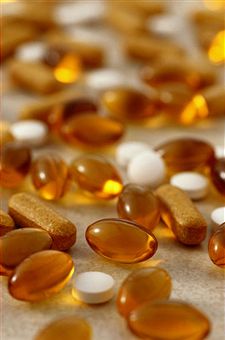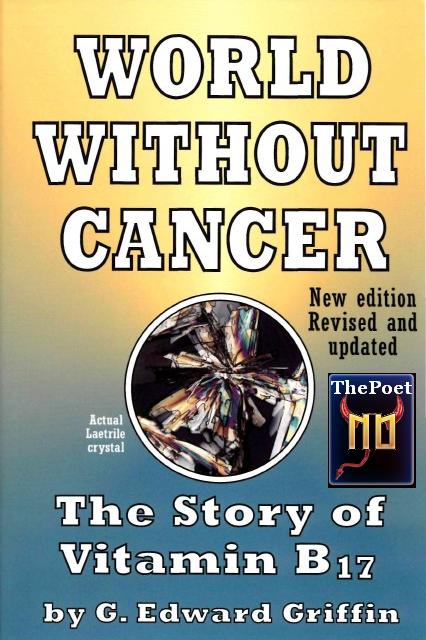Death by doctoring (2)
by Steven Ransom
Extracted from his book
Great News on Cancer in the 21st Century
(Credence, 2002)
Read here the first part of this article
Reputation is everything
 But what relevance does all this have to the debate on treatments for cancer? Where is all of this headed? This has been a necessary diversion—firstly, that we might begin to understand some of the frustrations that many reasoned thinkers have with the issues raised; and secondly, that we might begin to consider the impact that such weakened thinking has on genuine natural treatments for disease. For instance, what damage is secondarily being wrought upon the reputation of the genuine treatments in the cabinet, the ones that can actually heal?
But what relevance does all this have to the debate on treatments for cancer? Where is all of this headed? This has been a necessary diversion—firstly, that we might begin to understand some of the frustrations that many reasoned thinkers have with the issues raised; and secondly, that we might begin to consider the impact that such weakened thinking has on genuine natural treatments for disease. For instance, what damage is secondarily being wrought upon the reputation of the genuine treatments in the cabinet, the ones that can actually heal?
Sadly, there is no clear division between the reputation of much of the unregulated alternative health industry and that of the many sensible and proven, non-conventional treatments available today. It has all become a horrible blur and is a point of major concern even to the non-orthodox regulatory bodies overseeing the alternative/complementary health movement. The whole arena is fraught with as many vested interests and misunderstandings as conventional health, but commentaries drawing such conclusions— even from those concerned bodies sympathetic to the natural approach—are viewed as almost heretical and somehow betraying the brotherhood of the alternative hierarchy.
Personally speaking, critical debate should commence as soon as possible with regard to those “helping” therapies that only temporarily distract the seriously ill. In need only of sensible advice and sensible treatment, these people can very quickly end up worse off in body, mind and spirit—and, last but not least, in pocket—leading very quickly to derision and a carte blanche dismissal of all the good that genuine natural treatments have to offer.
John Diamond stated that there was as much chance of his going down the alternative treatment route as there was of the Pope getting drunk on the communion wine and getting off with a couple of nuns. Whilst we can perhaps understand some of John Diamond’s frustrations, his comparisons don’t exactly aid the cause. Because the truth is that the alternativist’s cabinet is not all “mumbo jumbo” by any means. Genuine medicine can be found in there.
Perhaps a name change is in order. Are we alternative? Are we complementary? But complementary to what? To chemotherapy, perhaps? But then, what medicine could possibly complement chemotherapy? Shouldn’t there just be medicine and non-medicine, full stop? Be that as it may, many people are wrongly assuming that the non-orthodox medical cabinet is barren and not worthy of closer inspection.
The hazy and often crazy information being disseminated on numerous non-conventional treatments, coupled with our innate and naive trust in the orthodoxy, is the reason why thousands of people like John Diamond are staying with, and relying upon, conventional treatments for serious illnesses including cancer. As a result, thousands of people like John Diamond are dying, and often in a horrible fashion.
Vitamin B17
In his UK Observer article entitled “Quacks on the Rack”, John Diamond summarily dismissed what is arguably the most famous of the natural and proven anti-cancer treatments known to man: the natural extract of the apricot kernel, otherwise known as vitamin B17.
“Supporters of laetrile (vitamin B17) and Essiac, in particular, made so much noise about their miracle cures that both have been through the research mill on numerous occasions and found to be useless.”
 Vitamins C and B17 (also called laetrile) have longstanding success in cancer prevention and treatment, yet the orthodox medical profession continues to deny their benefits.
Vitamins C and B17 (also called laetrile) have longstanding success in cancer prevention and treatment, yet the orthodox medical profession continues to deny their benefits.
Now we can ask ourselves whether it was perhaps the fault of some kindly but misguided soul who posted John Diamond an essay on the benefits of vitamin B17 mixed with walnut water which caused him to dismiss B17 so emphatically. Or was it that John actually trusted the conventional research reports he had accrued on this vitamin?
Interestingly, Dr Dean Burk, the former head of the Cytochemistry Department of the National Cancer Institute and one of the co-founders of this famous American medical institu¬tion, had personally worked on vitamin B17. He described this substance in very different terms: “When we add laetrile to a cancer culture under the microscope,” said Dr Burk, “providing the enzyme glucosidase also is present, we can see the cancer cells dying off like flies.”
Glucosidase is the enzyme heavily present in cancerous cells, which triggers the unique cancer-destroying mechanism found in vitamin B17. An excellent clinical analysis of this mechanism is found in B17 Metabolic Therapy – In the Prevention and Control of Cancer, a concise history of the research into this vitamin, including many clinical assessments.)
Dr Burk also stated that, evidence for laetrile’s efficacy had been noted in at least five independent institutions in three widely separated countries of the world. So whom do we trust in this matter? Diamond or Burk? By looking at where John Diamond might have got his B17 research “information”, the ugly features of conventional cancer research move more sharply into focus.
Because of the Money
Cancer is big business, and knowledge claims on any treatment; that earn money and, conversely, on any treatments that do not earn money for the drug companies are never neutral.
Dr Ralph Moss served as the Assistant Director of Public Affairs at America’s most famous cancer research institution, Memorial Sloan-Kettering in Manhattan. He knows the cancer industry inside out. Read what he had to say in an April 1994 interview with Laura Lee, and judge for yourself the quality of the evidence against the effectiveness of vitamin B17: Dr Moss: “Shortly after I went to work [at the Sloan-Kettering Cancer Institute], I visited the elderly Japanese scientist Kanematsu Sugiura, who astonished me when he told me he was working on laetrile (B17). At the time it was the most controversial thing in cancer, reputed to be a cure for cancer. We in Public Affairs were giving out statements that laetrile was worthless, it was quackery, and that people should not abandon proven therapies. I was astonished that our most distinguished scientist would be bothering with something like this, and I said, ‘Why are you doing this if it doesn’t work?’ He took down his lab books and showed me that, in fact, laetrile was dramatically effective in stopping the spread of cancer.”
Laura Lee: “So this is verified, that laetrile can have this positive effect?”
Moss: “We were finding this and yet we in Public Affairs were told to issue statements to the exact opposite of what we were finding scientifically.”
Unable to sit on this information, Dr Moss later called a press conference of his own and, before a battery of reporters and cam¬eramen, charged that Sloan-Kettering officials had engineered a massive cover-up. He provided all the supporting documents and named all the names necessary to validate his case. The following day he was fired for “failing to carry out his most basic job responsibilities”.
 Similarly, in his book, World Without Cancer, cancer industry researcher G. Edward Griffin notes: “Every laetrile study had been tarnished with the same kind of scientific ineptitude, bias and outright deception… Some of these studies openly admitted evidence of anti-cancer effect, but has tened to attribute this effect to other causes. Some were toxicity studies only, which means that they weren’t trying to see if laetrile was effective, but merely to determine how much of it was required to kill the patient.”
Similarly, in his book, World Without Cancer, cancer industry researcher G. Edward Griffin notes: “Every laetrile study had been tarnished with the same kind of scientific ineptitude, bias and outright deception… Some of these studies openly admitted evidence of anti-cancer effect, but has tened to attribute this effect to other causes. Some were toxicity studies only, which means that they weren’t trying to see if laetrile was effective, but merely to determine how much of it was required to kill the patient.”
The “evidence” supporting John Diamond’s claim that vitamin B17 is useless and even dangerous is available in abundance in all of the major cancer institutions today. Well, of course it is! We’re in the merchant’s house, don’t forget! As Pat Rattigan, author of The Cancer Business, reports: “The threat to the cancer business Tom effective therapies was taken very seriously from the beginning. By the 1940s, the Syndicate had 300,000 names on its ‘quack’ files. Vitamin B17, being a unique threat due to its simplicity, attracted more concentrated attacks than all the other treatments put together: fraudulent test reports; hired, banner-carrying pickets outside clinics; rigged juries; newspaper character assassinations; dismissal of heretic employees; etc. The FDA, orchestrating the onslaught, sent out 10,000 posters and hundreds of thousands of leaflets warning about the dangers of the toxicity of the non-toxic substance. Earlier, a Congressional Accounting Office had found that 350 FDA employees had shares in, or had refused to declare an interest in, the pharmaceutical industry.”
The American Food and Drug Administration issued one such story about the death of an 11-month-old girl, supposedly from cyanide poisoning due to her apparently swallowing her father’s vitamin B17 tablets. Cancer specialist and B17 advocate Dr Harold Manner takes up the story: “I was lecturing in Buffalo, New York and… after I had made some strong statements, a man stood up and said, ‘Dr Manner, how in the world can you make statements like that when the FDA is making these other statements?’ I reiterated that the FDA statements were lies. He said, ‘Look at this little girl in upstate New York; she took her father’s laetrile tablets and died of cyanide poisoning.’ Just then, a little lady stood up: ‘Dr Manner, let me answer that question. I think I am entitled to because I am that little baby’s mother. That baby never touched her father’s laetrile tablets. The doctor, knowing the father was on laetrile, marked down “possible cyanide poisoning”. At the hospital they used a cyanide antidote and it was the antidote that killed the child. And yet that statement will continue to appear, even though they know it is a lie.'”
“When we add laetrile to a cancer culture under the microscope,” said Dr Burk, “providing the enzyme glucosidase also is present, we can see the cancer cells dying off like flies.”
The scare stories always focus on the minute amounts of naturally occurring cyanide found in vitamin B17. But no mention is made in any of these stories of the wondrous mechanism governing the release of this cyanide. No harm is done to the person eating this vitamin (if that were the case, we’ve consumed enough apricots, apples, peaches, cherries, etc. containing B17 to have finished us off long ago). The cyanide is released only when cancerous cells are recognized by their high glucosidase content. B17 cyanide attacks cancer cells specifically. No large amounts of glucosidase detected means no cyanide release. Rest assured, there is no evidence that vitamin B17 can kill—unless, of course, one is accidentally crushed under a pallet of the stuff!
A further embarrassment for the cancer orthodoxy must surely be the research being carried out at the Imperial College in London, where researchers are looking at ways of using naturally occurring plant cyanide specifically to attack human bowel tumors. The idea came about after studying the pattern of specific cyanide release in the almond and cassava fruit which protects them from insect attack. Another one of those natural wonders, just crying out to be heard, is at last being listened to by the orthodoxy, perhaps?
 Very sadly, in assessing the deservedness of the “shady” reputation bestowed upon vitamin B17 metabolic therapy, we realize it is entirely unwarranted and that, instead, there has been a sustained attack by the conventional cancer industry on this treatment—an attack that has been carried on in one form or another for the last 40 years.
Very sadly, in assessing the deservedness of the “shady” reputation bestowed upon vitamin B17 metabolic therapy, we realize it is entirely unwarranted and that, instead, there has been a sustained attack by the conventional cancer industry on this treatment—an attack that has been carried on in one form or another for the last 40 years.
As mentioned earlier, with global spending on conventional cancer running into the hundreds of billions annually, a naturally occurring cancer cure of any description is an unwanted intruder.
Here is Dr Moss, again from the April 1994 Laura Lee interview, this time on the money involved in conventional cancer:
Moss: “About 630,000 people die every year of cancer in the US, and it really is an epidemic disease. We have got a tremendous industry. Every one of those people who is getting cancer and dying of it is going to be treated, and these treatments are extremely expensive. Chemo is [coated at] tens of thousands, sometimes hundreds of thousands of dollars. A bone marrow transplant, which is basically another way of giving chemotherapy, or radiation, can run to about $150,000 per person, and is almost never effective. It kills about 25 per cent of the patients.”
Lee: “Why carry on doing it?”
Moss: “Because of the money, which is tremendous.”
When we understand the amounts of money involved, we can begin to understand the in-house desire to sustain a “fact-creating” process in support of conventional treatment. Conventional cancer treatment and cancer research are a license to print money. Most definitely, conventional interested parties and institutions have colluded in a shameful anti-vitamin B17 “fact-creating” process, which in turn has surely led to the early and unnecessary deaths of thousands upon thousands of people. As for John Diamond’s dismissal of vitamin B17, he didn’t write his comments on B17 as an intentional slur. He wasn’t the forked tongue in this chain of events. He desperately wanted to live. His single paragraph read by thousands was just another example of the damaging knock-on effect of merchant-speak. Merchant-speak on vitamin B17 metabolic therapy have exacted a grave injustice upon this treatment, and subsequently upon all who have been persuaded to think likewise. Let’s now look at some testimonies from those who have not been persuaded by the negative propaganda.
• Phillip
Phillip is 64. In April 2001, he was diagnosed with inoperable lung cancer. The oncologist showed him the X-rays that con¬firmed the dreaded “shadows”. He was told to go home, enjoy his life as best he could and put his affairs in order. A week later, in a chance conversation at work, Phillip was told about vitamin B17. Phillip immediately began taking a combination of vitamin B17 and vitamin C. Four months later, Phillip returned to hospital for a check-up, where a new set of X-rays was taken. The shadows had completely disap¬peared. Says Phillip: “I know what I saw, and the doctor couldn’t explain it. I’m continuing with my vitamin B17 regime and eating about 10 kernels a day.”30 Phillip now pays great attention to his diet and believes that what we put into our bodies can have a dramatic effect medicinally.
Article from Nexus Magazine August-September 2002
Read also:
Death by doctoring (3)
yogaesoteric
